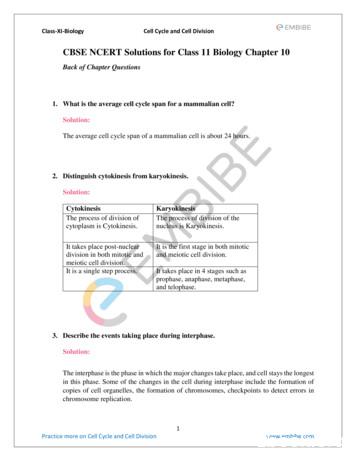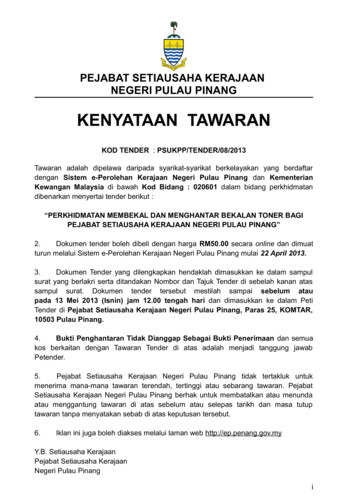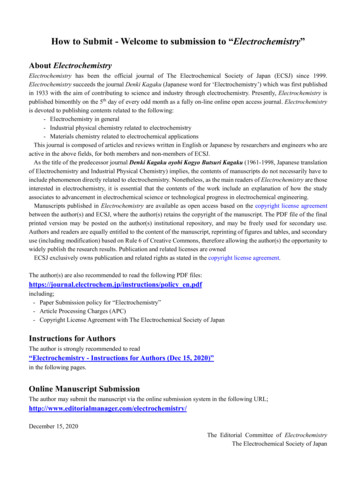The Cell Cycle - WordPress
Chapter 12 Overview: The Key Roles of Cell Division The continuity of lifeThe Cell Cycle– Is based upon the reproduction of cells, or celldivisionPowerPoint Lectures forBiology, Seventh EditionNeil Campbell and Jane ReeceLectures by Chris RomeroFigure 12.1Copyright 2005 Pearson Education, Inc. publishing as Benjamin CummingsCopyright 2005 Pearson Education, Inc. publishing as Benjamin Cummings Unicellular organisms– Reproduce by cell division Multicellular organisms depend on cell divisionfor– Development from a fertilized cell100 µm– Growth– Repair200 µm(a) Reproduction. An amoeba,a single-celled eukaryote, isdividing into two cells. Eachnew cell will be an individualorganism (LM).Figure 12.2 ACopyright 2005 Pearson Education, Inc. publishing as Benjamin Cummings The cell division process– Is an integral part of the cell cycle20 µm(b) Growth and development.(c) Tissue renewal. These dividingThis micrograph shows abone marrow cells (arrow) willsand dollar embryo shortlygive rise to new blood cells (LM).after the fertilized egg divided,Figure 12.2 B, C forming two cells (LM).Copyright 2005 Pearson Education, Inc. publishing as Benjamin Cummings Concept 12.1: Cell division results ingenetically identical daughter cells Cells duplicate their genetic material– Before they divide, ensuring that eachdaughter cell receives an exact copy of thegenetic material, DNACopyright 2005 Pearson Education, Inc. publishing as Benjamin CummingsCopyright 2005 Pearson Education, Inc. publishing as Benjamin Cummings1
Cellular Organization of the Genetic Material A cell’s endowment of DNA, its geneticinformation The DNA molecules in a cell– Are packaged into chromosomes– Is called its genomeFigure 12.350 µmCopyright 2005 Pearson Education, Inc. publishing as Benjamin CummingsCopyright 2005 Pearson Education, Inc. publishing as Benjamin CummingsDistribution of Chromosomes During Cell Division Eukaryotic chromosomes In preparation for cell division– Consist of chromatin, a complex of DNA andprotein that condenses during cell division– DNA is replicated and the chromosomescondense In animals– Somatic cells have two sets of chromosomes– Gametes have one set of chromosomesCopyright 2005 Pearson Education, Inc. publishing as Benjamin CummingsCopyright 2005 Pearson Education, Inc. publishing as Benjamin Cummings Each duplicated chromosome Eukaryotic cell division consists of– Has two sister chromatids, which separateduring cell division0.5 µmA eukaryotic cell has multiplechromosomes, one of which isrepresented here. Beforeduplication, each chromosomehas a single DNA molecule.Once duplicated, a chromosomeconsists of two sister chromatidsconnected at the centromere. Eachchromatid contains a copy of theDNA molecule.Mechanical processes separatethe sister chromatids into twochromosomes and distributethem to two daughter cells.Figure 12.4Copyright 2005 Pearson Education, Inc. publishing as Benjamin Cummings– Sex cells are produced after a reduction inchromosome numberCentromereCentromeres– Cytokinesis, the division of the cytoplasm In meiosisChromosomeduplication(including DNAsynthesis)Separationof sisterchromatids– Mitosis, the division of the nucleusSisterchromatidsSister chromatidsCopyright 2005 Pearson Education, Inc. publishing as Benjamin Cummings2
Phases of the Cell Cycle Concept 12.2: The mitotic phase alternateswith interphase in the cell cycle A labeled probe can reveal patterns of geneexpression in different kinds of cells The cell cycle consists of– The mitotic phase– InterphaseINTERPHASES(DNA synthesis)CM ytoito kisi nes sisG1G2MIT(M OT) P ICHASEFigure 12.5Copyright 2005 Pearson Education, Inc. publishing as Benjamin CummingsCopyright 2005 Pearson Education, Inc. publishing as Benjamin Cummings Interphase can be divided into subphases– G1 phase The mitotic phase– Is made up of mitosis and cytokinesis– S phase– G2 phaseCopyright 2005 Pearson Education, Inc. publishing as Benjamin CummingsCopyright 2005 Pearson Education, Inc. publishing as Benjamin Cummings Mitosis consists of five distinct phases– Metaphase– Prophase– Anaphase– Prometaphase– TelophaseG2 OFINTERPHASECentrosomes(with centriole pairs) Chromatin(duplicated)Figure 12.6NucleolusNuclearPlasmaenvelope membranePROPHASEEarly mitoticspindleAsterCentromereChromosome, consistingof two sister chromatidsCopyright 2005 Pearson Education, Inc. publishing as Benjamin f remicrotubuleANAPHASEMetaphaseplateFigure 12.6SpindleCentrosome at Daughterone spindle pole chromosomesTELOPHASE AND velopeformingCopyright 2005 Pearson Education, Inc. publishing as Benjamin Cummings3
The Mitotic Spindle: A Closer Look The mitotic spindle The spindle arises from the centrosomes– Is an apparatus of microtubules that controlschromosome movement during mitosisCopyright 2005 Pearson Education, Inc. publishing as Benjamin CummingsCopyright 2005 Pearson Education, Inc. publishing as Benjamin Cummings Some spindle microtubules– In anaphase, sister chromatids separateAttach to the kinetochores of chromosomes and move thechromosomes to the metaphase plateAsterSisterchromatids– And includes spindle microtubules and astersCentrosome– And move along the kinetochore microtubulestoward opposite ends of the cellMetaphasePlateEXPERIMENTKinetochores1 The microtubules of a cell in early anaphase were labeled with a fluorescent dyethat glows in the microscope tochoresmicrotubulesMicrotubulesKinetochore0.5 µmChromosomesSpindlepoleFigure 12.8Figure 12.7 Centrosome1 µmCopyright 2005 Pearson Education, Inc. publishing as Benjamin CummingsCopyright 2005 Pearson Education, Inc. publishing as Benjamin CummingsCytokinesis: A Closer Look Nonkinetechore microtubules from oppositepoles– Overlap and push against each other,elongating the cell In animal cells– Cytokinesis occurs by a process known ascleavage, forming a cleavage furrow In telophase– Genetically identical daughter nuclei form atopposite ends of the cellCleavage furrowContractile ring ofmicrofilamentsFigure 12.9 ACopyright 2005 Pearson Education, Inc. publishing as Benjamin Cummings100 µmDaughter cells(a) Cleavage of an animal cell (SEM)Copyright 2005 Pearson Education, Inc. publishing as Benjamin Cummings4
In plant cells, during cytokinesis– A cell plate forms Mitosis in a plant cellChromatineNucleusNucleolus condensingVesiclesformingcell plate1 µmWall ofpatent cell Cell plate New cell wallDaughter cellsFigure 12.9 B(b) Cell plate formation in a plant cell (SEM)Copyright 2005 Pearson Education, Inc. publishing as Benjamin CummingsChromosomeMetaphase. The2 Prometaphase.3 spindle is complete, 41 Prophase.The chromatinWe now see discreteand the chromosomes,is condensing.chromosomes; eachattached to microtubulesThe nucleolus isconsists of twoat their kinetochores,beginning toidentical sisterare all at the metaphasedisappear.chromatids. Laterplate.Although notin prometaphase, theyet visiblenuclear envelop willin the micrograph,fragment.the mitotic spindle isstaring to from.Anaphase. The5chromatids of eachchromosome haveseparated, and thedaughter chromosomesare moving to the endsof cell as theirkinetochoremicrotubles shorten.Telophase. Daughternuclei are forming.Meanwhile, cytokinesishas started: The cellplate, which willdivided the cytoplasmin two, is growingtoward the perimeterof the parent cell.Figure 12.10Copyright 2005 Pearson Education, Inc. publishing as Benjamin CummingsBinary Fission Prokaryotes (bacteria)– Reproduce by a type of cell division calledbinary fission In binary fission– The bacterial chromosome replicates– The two daughter chromosomes actively move apartOrigin ofreplicationCell wallE. coli cellChromosome replication1 begins.Soon thereafter, one copy of theorigin moves rapidly toward theother end of the cell.2 Replication continues. One copy ofthe origin is now at each end ofthe cell.Two copiesof n3 Replication finishes. The plasmamembrane grows inward, andnew cell wall is deposited.Figure 12.11 4 Two daughter cells result.Copyright 2005 Pearson Education, Inc. publishing as Benjamin CummingsCopyright 2005 Pearson Education, Inc. publishing as Benjamin CummingsThe Evolution of Mitosis Since prokaryotes preceded eukaryotes bybillions of years– It is likely that mitosis evolved from bacterialcell division Certain protists– Exhibit types of cell division that seemintermediate between binary fission andmitosis carried out by most eukaryotic cells A hypothetical sequence for the evolution of mitosis(a) Prokaryotes. During binary fission, the origins of thedaughter chromosomes move to opposite ends of thecell. The mechanism is not fully understood, butproteins may anchor the daughter chromosomes tospecific sites on the plasma membrane.(b) Dinoflagellates. In unicellular protists calleddinoflagellates, the nuclear envelope remains intactduring cell division, and the chromosomes attach to thenuclear envelope. Microtubules pass through thenucleus inside cytoplasmic tunnels, reinforcing thespatial orientation of the nucleus, which then divides in afission process reminiscent of bacterial division.(c) Diatoms. In another group of unicellular protists, thediatoms, the nuclear envelope also remains intactduring cell division. But in these organisms, themicrotubules form a spindle within the nucleus.Microtubules separate the chromosomes, and thenucleus splits into two daughter nuclei.(d) Most eukaryotes. In most other eukaryotes,including plants and animals, the spindle formsoutside the nucleus, and the nuclear envelopebreaks down during mitosis. Microtubulesseparate the chromosomes, and the nuclearenvelope then re-forms.Figure 12.12 A-DCopyright 2005 Pearson Education, Inc. publishing as Benjamin Intact nuclearenvelopeKinetochoremicrotubulesIntact agments ofnuclear envelopeCopyright 2005 Pearson Education, Inc. publishing as Benjamin Cummings5
Evidence for Cytoplasmic Signals Concept 12.3: The cell cycle is regulated by amolecular control system Molecules present in the cytoplasm– Regulate progress through the cell cycleEXPERIMENTS In each experiment, cultured mammalian cells at two different phases of the cell cycle were induced to fuse. The frequency of cell divisionExperiment 1Experiment 2SM– Varies with the type of cell These cell cycle differencesG1G1RESULTS– Result from regulation at the molecular levelSSMWhen a cell in the Sphase was fused witha cell in G1, the G1 cellimmediately entered theS phase—DNA wassynthesized.MWhen a cell in the M phasewas fused with a cell in G1, theG1 cell immediately began mitosis—a spindle formed and chromatincondensed, even though thechromosome had not been duplicated.CONCLUSION The results of fusing cells at two different phases of the cell cycle suggest that molecules present in thecytoplasm of cells in the S or M phase control the progression of phases.Figure 12.13 A, BCopyright 2005 Pearson Education, Inc. publishing as Benjamin CummingsCopyright 2005 Pearson Education, Inc. publishing as Benjamin CummingsThe Cell Cycle Control System The sequential events of the cell cycle– Are directed by a distinct cell cycle controlsystem, which is similar to a clock The clock has specific checkpoints– Where the cell cycle stops until a go-ahead signal isreceivedG1 checkpointControlsystemG0SG1 checkpointG1MG2G1G1M checkpointFigure 12.14G2 checkpointCopyright 2005 Pearson Education, Inc. publishing as Benjamin CummingsThe Cell Cycle Clock: Cyclins andCyclin-Dependent Kinases Two types of regulatory proteins are involved incell cycle controlFigure 12.15 A, B(b) If a cell does not receive a go-aheadsignal at the G1checkpoint, the cellexits the cell cycle and goes into G0, anondividing state.(a) If a cell receives a go-ahead signal atthe G1 checkpoint, the cell continueson in the cell cycle.Copyright 2005 Pearson Education, Inc. publishing as Benjamin Cummings The activity of cyclins and Cdks– Fluctuates during the cell cycle(a) Fluctuation of MPF activity andcyclin concentration duringthe cell cycleMG1 S G2 MG1 S G2 MMPF activityCyclin Cyclins and cyclin-dependent kinases (Cdks)Time(b) Molecular mechanisms thathelp regulate the cell cycle1 Synthesis of cyclin begins in late Sphase and continues through G2.Because cyclin is protected fromdegradation during this stage, itaccumulates.GCdk4 During anaphase, the cyclin componentCopyright 2005 Pearson Education, Inc. publishing as Benjamin Cummingsof MPF is degraded, terminating the Mphase. The cell enters the G1 phase.G2MDegradedCyclinCyclin isdegradedFigure 12.16 A, BSthe cell favor degradationof cyclin, and the Cdkcomponent of MPF isrecycled.15 During G1, conditions inG2CdkcheckpointMPFCyclin2 Accumulated cyclin moleculescombine with recycled Cdk molecules, producing enough moleculesof MPF to pass the G2 checkpoint andinitiate the events of mitosis.3 MPF promotes mitosis by phosphorylatingvarious proteins. MPF‘s activity peaks duringmetaphase.Copyright 2005 Pearson Education, Inc. publishing as Benjamin Cummings6
Stop and Go Signs: Internal and External Signals atthe Checkpoints Both internal and external signals Growth factors– Stimulate other cells to divideEXPERIMENT– Control the cell cycle checkpointsScalpels1 A sample of connective tissue was cut upinto small pieces.Petriplate2 Enzymes were used to digest the extracellular matrix,resulting in a suspension of free fibroblast cells.3 Cells were transferred to sterile culture vesselsFigure 12.17Copyright 2005 Pearson Education, Inc. publishing as Benjamin Cummingscontaining a basic growth medium consisting ofglucose, amino acids, salts, and antibiotics (as aWithout PDGFprecaution against bacterial growth). PDGF wasadded to half the vessels. The culture vesselswere incubated at 37 C.With PDGFCopyright 2005 Pearson Education, Inc. publishing as Benjamin Cummings In density-dependent inhibition Cancer cells– Crowded cells stop dividing Most animal cells exhibit anchorage dependence– Exhibit neither density-dependent inhibition noranchorage dependence– In which they must be attached to a substratum todivide(a) Normal mammalian cells. Theavailability of nutrients, growthfactors, and a substratum forattachment limits celldensity to a single layer.When cells have formed a complete single layer,they stop dividing(density-dependent inhibition).If some cells are scraped away, the remaining cellsdivide to fill the gap and then stop (density-dependentinhibition).Figure 12.18 ACancer cells do not exhibitanchorage dependence ordensity-dependent inhibition.Cells anchor to dish surface anddivide (anchorage dependence).(b) Cancer cells. Cancer cells usuallycontinue to divide well beyond asingle layer, forming a clump ofoverlapping cells.Figure 12.18 B25 µm25 µmCopyright 2005 Pearson Education, Inc. publishing as Benjamin CummingsCopyright 2005 Pearson Education, Inc. publishing as Benjamin CummingsLoss of Cell Cycle Controls in Cancer Cells Cancer cells– Do not respond normally to the body’s controlmechanisms– Form tumors Malignant tumors invade surrounding tissuesand can metastasize– Exporting cancer cells to other parts of thebody where they may form secondary tumorsLymphvesselTumorBloodvesselGlandulartissue1 A tumor grows from asingle cancer cell.Cancer cell2 Cancer cells invadeneighboring tissue.Figure 12.19Copyright 2005 Pearson Education, Inc. publishing as Benjamin Cummings3 Cancer cells spreadthrough lymph andblood vessels toother parts of the body.MetastaticTumor4 A small percentage ofcancer cells may surviveand establish a new tumorin another part of the body.Copyright 2005 Pearson Education, Inc. publishing as Benjamin Cummings7
Apr 12, 2012 · Concept 12.3: The cell cycle is regulated by a molecular control system In each experiment, cultured mammalian cells at two different phases of the cell cycle were induced to fuse. The frequency of cell division – Varies with the type of cell 1 These cell cycle differences – Result from regulation at the molecular level
May 02, 2018 · D. Program Evaluation ͟The organization has provided a description of the framework for how each program will be evaluated. The framework should include all the elements below: ͟The evaluation methods are cost-effective for the organization ͟Quantitative and qualitative data is being collected (at Basics tier, data collection must have begun)
Silat is a combative art of self-defense and survival rooted from Matay archipelago. It was traced at thé early of Langkasuka Kingdom (2nd century CE) till thé reign of Melaka (Malaysia) Sultanate era (13th century). Silat has now evolved to become part of social culture and tradition with thé appearance of a fine physical and spiritual .
On an exceptional basis, Member States may request UNESCO to provide thé candidates with access to thé platform so they can complète thé form by themselves. Thèse requests must be addressed to esd rize unesco. or by 15 A ril 2021 UNESCO will provide thé nomineewith accessto thé platform via their émail address.
̶The leading indicator of employee engagement is based on the quality of the relationship between employee and supervisor Empower your managers! ̶Help them understand the impact on the organization ̶Share important changes, plan options, tasks, and deadlines ̶Provide key messages and talking points ̶Prepare them to answer employee questions
Dr. Sunita Bharatwal** Dr. Pawan Garga*** Abstract Customer satisfaction is derived from thè functionalities and values, a product or Service can provide. The current study aims to segregate thè dimensions of ordine Service quality and gather insights on its impact on web shopping. The trends of purchases have
of the cell and eventually divides into two daughter cells is termed cell cycle. Cell cycle includes three processes cell division, DNA replication and cell growth in coordinated way. Duration of cell cycle can vary from organism to organism and also from cell type to cell type. (e.g., in Yeast cell cycle is of 90 minutes, in human 24 hrs.)
Chính Văn.- Còn đức Thế tôn thì tuệ giác cực kỳ trong sạch 8: hiện hành bất nhị 9, đạt đến vô tướng 10, đứng vào chỗ đứng của các đức Thế tôn 11, thể hiện tính bình đẳng của các Ngài, đến chỗ không còn chướng ngại 12, giáo pháp không thể khuynh đảo, tâm thức không bị cản trở, cái được
Class-XI-Biology Cell Cycle and Cell Division 1 Practice more on Cell Cycle and Cell Division www.embibe.com CBSE NCERT Solutions for Class 11 Biology Chapter 10 Back of Chapter Questions 1. What is the average cell cycle span for a mammalian cell? Solution: The average cell cycle span o























